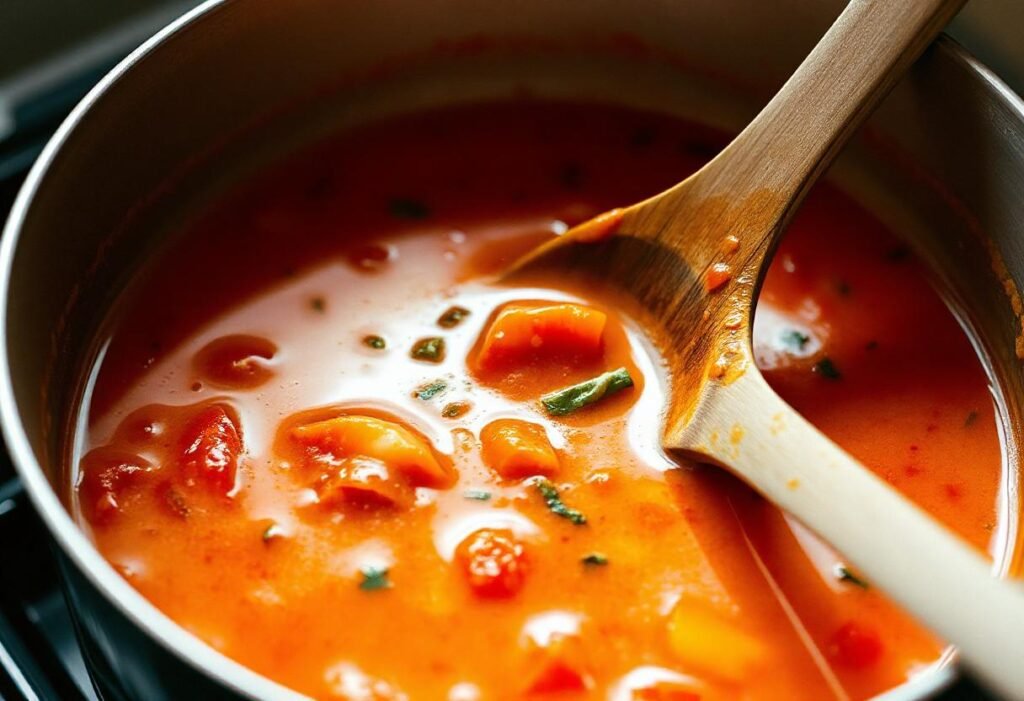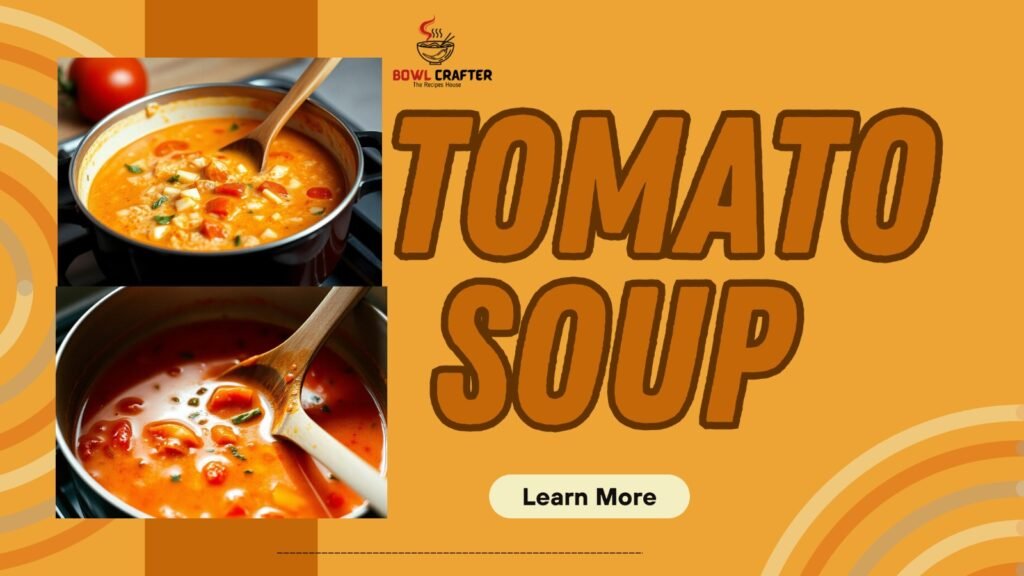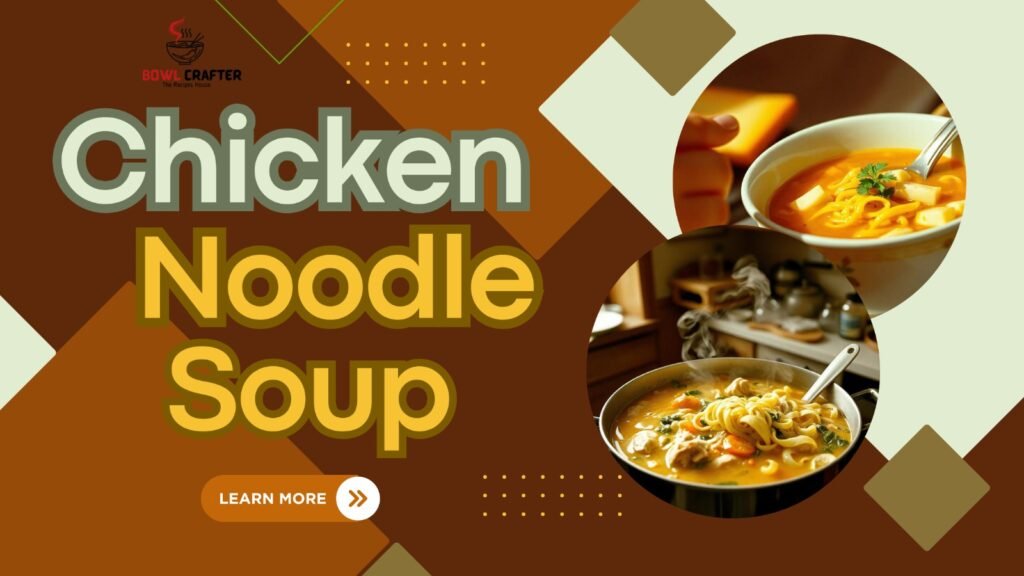Table of Contents
Introduction : Tomato Soup Recipe

Tomato soup is one of those dishes which are considered to be rather traditional; this dish has always been, and continues to be, a source of warmth for a great number of people. It is easy to prepare and is especially yummy when taken during cold weather or as a snack or even a meal to those who prefer small portions. For every homeowner who enjoys cooking, it is indispensable to learn a good tomato soup recipe because the dish is flexible for alteration.
This article will discuss factors such as the history of tomato soup, the nutritional value and the key components, the process of preparing tomato soup and many others to enable you to prepare the right tomato soup.
History of Tomato Soup
Tomato soup history can be traced back to the 18th century when tomatoes appeared as a new addition to Europeans’ table. At first customers did not trust this food product, but gradually it became a frequent addition to meals, especially in Mediterranean states. There are several derivatives of tomato soup which have followed the change in culture, the French type that contains thick cream as well as the spicy tomato soup with herbs introduced in India. Tomato soup is consumed all across the globe, every culture putting its spin on the dish, and it can therefore be considered an important staple for many cultures.
Health Benefits of Tomato Soup
The essence of tomato juice can be seen in the fact that it is not only tasty and warm – it furthers the purpose of a healthy meal in your diet agenda. Below are some of the key health benefits of tomato soup:
- Rich in Nutrients:
- Vitamins and Minerals: Tomatoes are packed with content of vitamins among these are vitamin C, A and K as well as minerals such as potassium and folic acids. They are crucial in supporting the body’s health activities and in stimulating health processes within the body.
- Antioxidants: Tomatoes are a very good source of antioxidants, especially lycopene which gives red color to the fruits of this category. Lycopene ;Reduces chances of chronic diseases including; Cardiovascular problems and some form of cancer.
- Heart Health:
- Lycopene: The natural chemical compound known as lycopene within tomatoes has the potential of preventing the oxidation and inflammation which are horrid promoters of heart diseases. Lycopene also contributes to the oxidation of LDL cholesterol and dilatation of the blood vessels, and thus cardiovascular disease .
- Potassium: It also measures up well in potassium, a mineral that in conjunction with sodium has the capacity to regulate high blood pressure especially tomato soup. Potassium should be taken in a moderate way and not be less or more to prevent occurrence of stroke and heart diseases.
- Supports Digestive Health:
- Fiber Content: Tomatoes include dietary fibre, which assist in the improvement of the digestive system in the body. Many of the fiber’s advantages are associated with defecation, the absence of constipation and frequent or infrequent bowel movements, and balanced intestinal microbiota.
- Hydration: Tomato soup is also a good supporter of digestion since it has a lot of water as the component of the preparation and does not lead to the formation of a deficiency of water in the body.
- Boosts Immune System:
- Vitamin C: The tomato soup is very nutritional since it has vitamin C and this is very vital during instances that one would wish to raise their immunity. Vitamin C is also useful in the creation of white blood cells that is utilized in fighting off infection and diseases.
- Anti-Inflammatory Properties: Tomatoes contain vitamin C, lycopenes which belong to carotenoids and anti-inflammatory which are helpful in prevention of diseases and immunity boosting.

Tomato Soup Recipe
Ingredients
- A basic tomato soup recipe requires only a few essential ingredients:
Fresh Tomatoes: Fresh ripe tomatoes make the soup tasty.
Onion and Garlic: These aromatics turn it into something denser.
Olive Oil or Butter: For stir-frying and adding taste to the soup containing the grains.
Vegetable or Chicken Broth: Provides the base liquid.
Salt and Pepper: Essential seasonings for taste.
Optional Ingredients: Ingredients added to pizza sauce are Herbs such as basil or thyme, cream or any dairy produce to make it creamier or even sugar in case the tomatoes used are sour.
The quality of the ingredients should be top-notch at least for the first run in order to gain the best flavors. You can also try out some twists: For example, instead of using plain sun-dried tomatoes you can use roasted red peppers instead or bring them spicy by adding red pepper flakes.
Directions
- Sauté Aromatics: In a large pot over medium heat, sauté olive oil or butter. Put onions and garlic that have been chopped and sauté them until they are cooked and browned.
- Add Tomatoes: Take fresh tomatoes, wash and cut them and put them in the pot. Sautee them until they start deteriorating into small particles, roughly, approximately, for about 10 minutes.
- Simmer: Finally, add the brought broth into the mixture and allow boiling. Turn down the heat, the stew should now be placed back on the heat and allowed to stew for about 20-30 minutes.
- Blend: With an immersion blender, or if soup was cooled down a bit and transferred to a blender, blend until smooth. Go back to the pot if necessary.
- Season and Serve: This should be seasoned with some salt and black pepper to enable it suit the preferences of those who will be taking it. For the soupy consistency add cream, a little bit would be enough. It’s best served hot, preferably with your preferred garnishing on top.
Tips: So, in order to get the batter of desired smoothness, make sure you beat the soup roughly occasionally. If it thickens with the particular broth, then some more broth is added and if it is too thin, then it is thickened by allowing it to heat for sometime.
Common Mistakes: It is also important to note that over seasoning the food when preparing it is going to worsen the situation. It has to be noted that in each recipe it is crucial to give it a fine taste before the food is served.
Check Out: Cabbage Soup Recipe – Recipe#04
Variations and Additions
The classic tomato soup recipe can be easily customized:
- Roasted Tomato Soup: The celery should also be sautéed before being put into the pot, as should the tomatoes and garlic which should be roasted before being added.
- Creamy Tomato Soup: You may add heavy cream or coconut milk which makes the pasta very creamy.
- Herbed Tomato Soup: This step is believed to give the soup a natural aroma, add one cup of freshly chopped herbs such as basil, thyme, rosemary or any other preferred herb.
- Vegan/Dairy-Free: For a vegan rich cream substitute butter with olive oil and evaporated milk with coconut milk.
Serving Suggestions
One of the good meals that people enjoy are grilled cheese sandwiches and tomato soup and adding garlic butter to the sandwich is wise. The soup has a sour taste and is enjoyable to the palate; the cheese crisps are crunchy and buttery; acquainting the blend of cheese with the soup.
- Grilled Cheese Sandwich:
- One of the good meals that people enjoy are grilled cheese sandwiches and tomato soup and adding garlic butter to the sandwich is wise. The soup has a sour taste and is enjoyable to the palate; the cheese crisps are crunchy and buttery; acquainting the blend of cheese with the soup.
- Tip: Try other cheeses also like cheddar, mozzarella and Gruyère to see which one suits you most.
- Croutons:
- To enhance the meal, one can stir in homemade or bought croutons so as to give the tomato soup a crunchy feel in comparison to the smoothness of the soup.
- Tip: Garlicky butter or grated Parmesan can be added to the crouton mix before baking.
- Fresh Herbs:
- Finally, using freshly chopped herbs such as basil, parsley or chives on the tomato soup not only gives it a freshness and a little hint of aroma it also makes the dishes look more appetizing.
- Tip: To use the herbs as garnishing you need to use whole leaves or you could chop the herbs to create a finer touch of flavor into it.
- Parmesan Cheese:
- For garnishing, it’s recommended that one quickly grates some Parmesan Cheese and sprinkle on top of the soup, this gives it a salty, savory flavor that is excellent when combined with the sharpness of tomatoes.
- Tip: To intensify the taste even further you can add grated Parmesan cheese which has been aged or Pecorino Romano cheese.
- Toasted Bread or Baguette Slices:
- Fried bread can be served alongside the tomato soup or soup can be served with a piece of toast or a crusty baguette toast. The bread soaks up the soup and the result is a perfectly alright chewy texture.
- Tip: Take bread and rub it on a clove of garlic and then put it in the toaster and add some olive oil on top.
Tomato Soup Around the World
Tomato soup has many international variations:
- Gazpacho: A traditional/refreshing soup of tomatoes that is a speciality of Spain to beat the heat.
- Indian Spiced Tomato Soup: This is food seasoned with such spices as cumin, coriander and turmeric.
- Italian Tomato Soup: More often than not it has a subtle basil note and sometimes even Parmesan cheese.
All of these global twists demonstrate the possibility of the tomato soup recipe and its additional features presented by the participants.
Tips for Making the Best Tomato Soup
To elevate your tomato soup:
- Choose the Best Tomatoes: Use fully mature and tree-ripened tomatoes for the best taste of your food.
- Slow Cooking: To build up the combinations, with the heat rising above, it is here that one lets the so
- Roasting: In a bid to increase the flavor of the tomatoes as used in the preparation of the soup as well as to introduce that smoky flavor. tomatoes which are roasted before entering to the broth are used here
Conclusion : Tomato Soup Recipe
Tomato soup is not only a simple dish but also a blank check where chefs can show their imagination, as well as it is an ancient dish with a lot of useful properties. Herein below, we provide a checklist, which can be used as a general idea to make your own tomato soup recipe fit for your palate and lifestyle too!
Whatever changes you decide to make to the base recipe, making soup from tomatoes at home is a rather gratifying process. Do not forget to pass this to others, so you can share your favorite tomato soup recipes or your own new twist on the same—food is one of the few things in life that should be best enjoyed with others.
For more info : Click Here.
FAQs of Tomato Soup Recipe
Q1: What are the key ingredients for a basic tomato soup recipe?
There are several items that are the base or the fundamental to be used for the simple tomato soup; these include tomatoes, onions, garlic, oil or butter, stock, either vegetables or chicken stock, salt, and pepper. Other additions which I found to be optional but can add a lot to the soup are basil or thyme for more accentuated flavors, cream for creaminess or sugar in order to neutralize the sharpness of the tomatoes.
Q2: Can I use canned tomatoes instead of fresh tomatoes?
Yes, as you have rightly said that if fresh tomatoes are not there then you can very well use canned tomatoes. Canned tomatoes are used and they are satisfactory but fresh, vine-ripened tomatoes are suggested for better taste.
Q3: Can I freeze tomato soup for later use?
Yes, tomato soup freezes well. Pour the soup into a jar and let it cool’ before placing it in the refrigerator in an enclosed jar. It has a superb freezer stability and it can be frozen for up to three months, perfect as a freezer food. For the stewed meat, reheat it gently on the stove but if you notice that it is too thick add a bit of broth.



